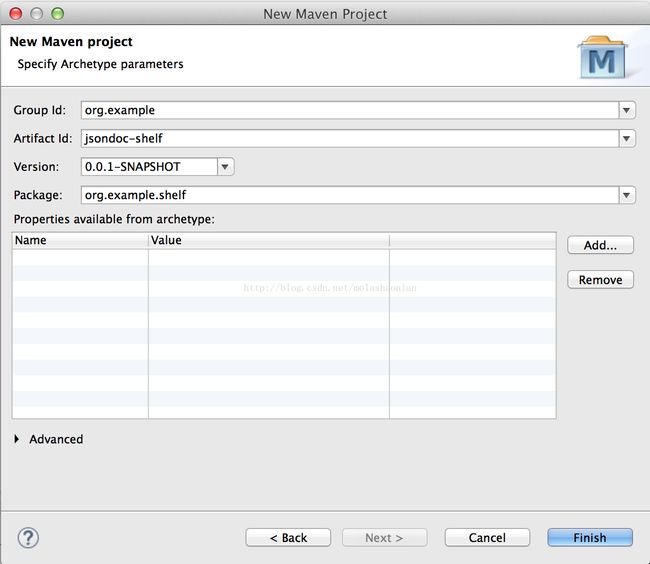使用 JSONDoc 记录 Spring Boot RESTful API
这个博文可以分为两部分:第一部分我将编写一个Spring Boot RESTful API,第二部分将介绍如何使用JSONDoc来记录创建的API。做这两个部分最多需要15分钟,因为使用Spring Boot创建一个API非常简单快捷,并且使用JSONDoc Spring Boot启动器和UI webjar进行记录也是如此。我将跳过这个例子的测试创建,因为主要目标是如何记录API而不是编写和测试它。
编写API
我们首先根据快速入门的原型创建Maven项目

并声明API所需的依赖关系:
- spring-boot-starter-web
- spring-boot-starter-data-jpa
- h2
xmlns="http://maven.apache.org/POM/4.0.0" xmlns:xsi="http://www.w3.org/2001/XMLSchema-instance"
xsi:schemaLocation="http://maven.apache.org/POM/4.0.0 http://maven.apache.org/xsd/maven-4.0.0.xsd">
- Book
- Author
创建 Entities 和 Controllers
为此,我将创建通常的组件来管理持久层和控制器层:
- 一个包名为
model将包含Book和Author - 一个包名为
repository将包含BookRepository和AuthorRepository - 一个包名为
controller将包含BookController和AuthorController
DatabasePopulator 类,实现 CommandLineRunner ,以便在启动时将在内存数据库中存在一些数据。我们来看看实体,存储库和控制器的代码:
Entities
package org.example.shelf.model;
import javax.persistence.Column;
import javax.persistence.Entity;
import javax.persistence.GeneratedValue;
import javax.persistence.GenerationType;
import javax.persistence.Id;
import javax.persistence.JoinColumn;
import javax.persistence.ManyToOne;
import lombok.Data;
import lombok.EqualsAndHashCode;
@Entity
@Data
@EqualsAndHashCode(exclude = "id")
public class Book {
@Id
@GeneratedValue(strategy = GenerationType.AUTO)
private Long id;
@Column(name = "title")
private String title;
@ManyToOne
@JoinColumn(name = "author_id")
private Author author;
}package org.example.shelf.model;
import java.util.ArrayList;
import java.util.List;
import javax.persistence.CascadeType;
import javax.persistence.Column;
import javax.persistence.Entity;
import javax.persistence.FetchType;
import javax.persistence.GeneratedValue;
import javax.persistence.GenerationType;
import javax.persistence.Id;
import javax.persistence.OneToMany;
import lombok.Data;
import lombok.EqualsAndHashCode;
import lombok.NoArgsConstructor;
import lombok.ToString;
import com.fasterxml.jackson.annotation.JsonIgnore;
@Entity
@Data
@NoArgsConstructor
@ToString(exclude = "books")
@EqualsAndHashCode(of = "name")
public class Author {
@Id
@GeneratedValue(strategy = GenerationType.AUTO)
private Long id;
@Column(name = "name")
private String name;
@JsonIgnore
@OneToMany(mappedBy = "author", fetch = FetchType.LAZY, cascade = CascadeType.ALL)
private List<Book> books = new ArrayList<Book>();
}Repositories
package org.example.shelf.repository;
import org.example.shelf.model.Book;
import org.springframework.data.jpa.repository.JpaRepository;
public interface BookRepository extends JpaRepository<Book, Long> {
}package org.example.shelf.repository;
import org.example.shelf.model.Author;
import org.springframework.data.jpa.repository.JpaRepository;
import org.springframework.stereotype.Repository;
public interface AuthorRepository extends JpaRepository<Author, Long> {
}Controllers
package org.example.shelf.controller;
import java.util.List;
import org.example.shelf.flow.ShelfFlowConstants;
import org.example.shelf.model.Book;
import org.example.shelf.repository.BookRepository;
import org.jsondoc.core.annotation.Api;
import org.jsondoc.core.annotation.ApiBodyObject;
import org.jsondoc.core.annotation.ApiMethod;
import org.jsondoc.core.annotation.ApiPathParam;
import org.jsondoc.core.annotation.ApiResponseObject;
import org.springframework.beans.factory.annotation.Autowired;
import org.springframework.http.HttpHeaders;
import org.springframework.http.HttpStatus;
import org.springframework.http.MediaType;
import org.springframework.http.ResponseEntity;
import org.springframework.web.bind.annotation.PathVariable;
import org.springframework.web.bind.annotation.RequestBody;
import org.springframework.web.bind.annotation.RequestMapping;
import org.springframework.web.bind.annotation.RequestMethod;
import org.springframework.web.bind.annotation.ResponseStatus;
import org.springframework.web.bind.annotation.RestController;
import org.springframework.web.util.UriComponentsBuilder;
@RestController
@RequestMapping(value = "/books", produces = MediaType.APPLICATION_JSON_VALUE)
public class BookController {
@Autowired
private BookRepository bookRepository;
@RequestMapping(value = "/{id}", method = RequestMethod.GET)
public Book findOne(@PathVariable Long id) {
return bookRepository.findOne(id);
}
@RequestMapping(method = RequestMethod.GET)
public List<Book> findAll() {
return bookRepository.findAll();
}
@RequestMapping(method = RequestMethod.POST, consumes = MediaType.APPLICATION_JSON_VALUE)
@ResponseStatus(value = HttpStatus.CREATED)
public ResponseEntity<Void> save(@RequestBody Book book, UriComponentsBuilder uriComponentsBuilder) {
bookRepository.save(book);
HttpHeaders headers = new HttpHeaders();
headers.setLocation(uriComponentsBuilder.path("/books/{id}").buildAndExpand(book.getId()).toUri());
return new ResponseEntity<Void>(headers, HttpStatus.CREATED);
}
@RequestMapping(value = "/{id}", method = RequestMethod.DELETE)
@ResponseStatus(value = HttpStatus.OK)
public void delete(@PathVariable Long id) {
Book book = bookRepository.findOne(id);
bookRepository.delete(book);
}
}package org.example.shelf.controller;
import java.util.List;
import org.example.shelf.flow.ShelfFlowConstants;
import org.example.shelf.model.Author;
import org.example.shelf.repository.AuthorRepository;
import org.jsondoc.core.annotation.Api;
import org.jsondoc.core.annotation.ApiBodyObject;
import org.jsondoc.core.annotation.ApiMethod;
import org.jsondoc.core.annotation.ApiPathParam;
import org.jsondoc.core.annotation.ApiResponseObject;
import org.springframework.beans.factory.annotation.Autowired;
import org.springframework.http.HttpHeaders;
import org.springframework.http.HttpStatus;
import org.springframework.http.MediaType;
import org.springframework.http.ResponseEntity;
import org.springframework.web.bind.annotation.PathVariable;
import org.springframework.web.bind.annotation.RequestBody;
import org.springframework.web.bind.annotation.RequestMapping;
import org.springframework.web.bind.annotation.RequestMethod;
import org.springframework.web.bind.annotation.ResponseStatus;
import org.springframework.web.bind.annotation.RestController;
import org.springframework.web.util.UriComponentsBuilder;
@RestController
@RequestMapping(value = "/authors", produces = MediaType.APPLICATION_JSON_VALUE)
public class AuthorController {
@Autowired
private AuthorRepository authorRepository;
@RequestMapping(value = "/{id}", method = RequestMethod.GET)
public Author findOne(@PathVariable Long id) {
return authorRepository.findOne(id);
}
@RequestMapping(method = RequestMethod.GET)
public List<Author> findAll() {
return authorRepository.findAll();
}
@RequestMapping(method = RequestMethod.POST, consumes = MediaType.APPLICATION_JSON_VALUE)
@ResponseStatus(value = HttpStatus.CREATED)
public ResponseEntity<Void> save(@RequestBody Author author, UriComponentsBuilder uriComponentsBuilder) {
authorRepository.save(author);
HttpHeaders headers = new HttpHeaders();
headers.setLocation(uriComponentsBuilder.path("/authors/{id}").buildAndExpand(author.getId()).toUri());
return new ResponseEntity<Void>(headers, HttpStatus.CREATED);
}
@RequestMapping(value = "/{id}", method = RequestMethod.DELETE)
@ResponseStatus(value = HttpStatus.OK)
public void delete(@PathVariable Long id) {
Author author = authorRepository.findOne(id);
authorRepository.delete(author);
}
}Database populator
package org.example.shelf;
import org.example.shelf.model.Author;
import org.example.shelf.model.Book;
import org.example.shelf.repository.AuthorRepository;
import org.example.shelf.repository.BookRepository;
import org.springframework.beans.factory.annotation.Autowired;
import org.springframework.boot.CommandLineRunner;
import org.springframework.context.annotation.Configuration;
@Configuration
public class DatabasePopulator implements CommandLineRunner {
@Autowired
private AuthorRepository authorRepository;
@Autowired
private BookRepository bookRepository;
public void run(String... arg0) throws Exception {
Author horbny = new Author();
horbny.setId(1L);
horbny.setName("Nick Horby");
Author smith = new Author();
smith.setId(2L);
smith.setName("Wilbur Smith");
authorRepository.save(horbny);
authorRepository.save(smith);
Book highFidelty = new Book();
highFidelty.setId(1L);
highFidelty.setTitle("High fidelty");
highFidelty.setAuthor(horbny);
Book aLongWayDown = new Book();
aLongWayDown.setId(2L);
aLongWayDown.setTitle("A long way down");
aLongWayDown.setAuthor(horbny);
Book desertGod = new Book();
desertGod.setId(3L);
desertGod.setTitle("Desert god");
desertGod.setAuthor(smith);
bookRepository.save(highFidelty);
bookRepository.save(aLongWayDown);
bookRepository.save(desertGod);
}
}Shelf 在这种情况下,我会称之为Spring Boot,这很简单:
package org.example.shelf;
import org.springframework.boot.SpringApplication;
import org.springframework.boot.autoconfigure.EnableAutoConfiguration;
import org.springframework.context.annotation.ComponentScan;
import org.springframework.data.jpa.repository.config.EnableJpaRepositories;
@EnableAutoConfiguration
@EnableJpaRepositories
@ComponentScan
public class Shelf {
public static void main(String[] args) {
SpringApplication.run(Shelf.class, args);
}
}curl -i http://localhost:8080/books/1
curl -i http://localhost:8080/books
curl -i http://localhost:8080/authors/1
curl -i http://localhost:8080/authors用JSONDoc记录API
这是有趣的和新的部分,即使用JSONDoc库来注释代码并自动生成其文档。要做到这一点,你必须声明JSONDoc依赖关系,并在你的类中插入一些代码。让我们看看如何做到这一点:
声明JSONDoc依赖关系
只需添加两个依赖关系到pom文件:
在主类中启用JSONDoc
使用JSONDoc启动器,您可以通过添加@EnableJSONDoc到Shelf类中来启用文档生成,如下所示:
package org.example.shelf;
import org.jsondoc.spring.boot.starter.EnableJSONDoc;
import org.springframework.boot.SpringApplication;
import org.springframework.boot.autoconfigure.EnableAutoConfiguration;
import org.springframework.context.annotation.ComponentScan;
import org.springframework.data.jpa.repository.config.EnableJpaRepositories;
@EnableAutoConfiguration
@EnableJpaRepositories
@EnableJSONDoc
@ComponentScan
public class Shelf {
public static void main(String[] args) {
SpringApplication.run(Shelf.class, args);
}
}配置JSONDoc
接下来要做的是配置JSONDoc来扫描您的控制器,对象和流类。要做到这一点,只需添加一些条目到application.properties文件(src/main/resources如果你没有它创建它)
jsondoc.version=1.0
jsondoc.basePath=http://localhost:8080
jsondoc.packages[0]=org.example.shelf.model
jsondoc.packages[1]=org.example.shelf.controller文档控制器
JSONDoc可以从Spring注释中获取几个信息来构建文档。无论如何,它是一个选择加入的过程,这意味着JSONDoc将仅在使用自己的注释注释时才扫描类和方法。例如,要正确记录BookController,这里是如何使用JSONDoc注释:
package org.example.shelf.controller;
import java.util.List;
import org.example.shelf.flow.ShelfFlowConstants;
import org.example.shelf.model.Book;
import org.example.shelf.repository.BookRepository;
import org.jsondoc.core.annotation.Api;
import org.jsondoc.core.annotation.ApiBodyObject;
import org.jsondoc.core.annotation.ApiMethod;
import org.jsondoc.core.annotation.ApiPathParam;
import org.jsondoc.core.annotation.ApiResponseObject;
import org.springframework.beans.factory.annotation.Autowired;
import org.springframework.http.HttpHeaders;
import org.springframework.http.HttpStatus;
import org.springframework.http.MediaType;
import org.springframework.http.ResponseEntity;
import org.springframework.web.bind.annotation.PathVariable;
import org.springframework.web.bind.annotation.RequestBody;
import org.springframework.web.bind.annotation.RequestMapping;
import org.springframework.web.bind.annotation.RequestMethod;
import org.springframework.web.bind.annotation.ResponseStatus;
import org.springframework.web.bind.annotation.RestController;
import org.springframework.web.util.UriComponentsBuilder;
@RestController
@RequestMapping(value = "/books", produces = MediaType.APPLICATION_JSON_VALUE)
@Api(description = "The books controller", name = "Books services")
public class BookController {
@Autowired
private BookRepository bookRepository;
@ApiMethod
@RequestMapping(value = "/{id}", method = RequestMethod.GET)
public @ApiResponseObject Book findOne(@ApiPathParam(name = "id") @PathVariable Long id) {
return bookRepository.findOne(id);
}
@ApiMethod
@RequestMapping(method = RequestMethod.GET)
public @ApiResponseObject List<Book> findAll() {
return bookRepository.findAll();
}
@ApiMethod
@RequestMapping(method = RequestMethod.POST, consumes = MediaType.APPLICATION_JSON_VALUE)
@ResponseStatus(value = HttpStatus.CREATED)
public @ApiResponseObject ResponseEntity<Void> save(@ApiBodyObject @RequestBody Book book, UriComponentsBuilder uriComponentsBuilder) {
bookRepository.save(book);
HttpHeaders headers = new HttpHeaders();
headers.setLocation(uriComponentsBuilder.path("/books/{id}").buildAndExpand(book.getId()).toUri());
return new ResponseEntity<Void>(headers, HttpStatus.CREATED);
}
@ApiMethod
@RequestMapping(value = "/{id}", method = RequestMethod.DELETE)
@ResponseStatus(value = HttpStatus.OK)
public void delete(@ApiPathParam(name = "id") @PathVariable Long id) {
Book book = bookRepository.findOne(id);
bookRepository.delete(book);
}
}AuthorController 。
文件对象
接下来要做的就是把一些JSONDoc注释也需要被记录在案,在这种情况下,对象Book和Author。这是Book类:
package org.example.shelf.model;
import javax.persistence.Column;
import javax.persistence.Entity;
import javax.persistence.GeneratedValue;
import javax.persistence.GenerationType;
import javax.persistence.Id;
import javax.persistence.JoinColumn;
import javax.persistence.ManyToOne;
import org.jsondoc.core.annotation.ApiObject;
import org.jsondoc.core.annotation.ApiObjectField;
import lombok.Data;
import lombok.EqualsAndHashCode;
@Entity
@Data
@EqualsAndHashCode(exclude = "id")
@ApiObject
public class Book {
@Id
@GeneratedValue(strategy = GenerationType.AUTO)
@ApiObjectField(description = "The book's ID")
private Long id;
@Column(name = "title")
@ApiObjectField(description = "The book's title")
private String title;
@ManyToOne
@JoinColumn(name = "author_id")
@ApiObjectField(description = "The book's author")
private Author author;
}Author 也是如此 。
检查点:启动应用程序
在开始记录流程之前,让我们启动应用程序,看看会发生什么:
- 如果你去
http://localhost:8080/jsondoc你会看到一个json,这是由JSONDoc生成的,它代表了基于控制器方法和模型对象上的注释的文档 - 如果你去
http://localhost:8080/jsondoc-ui.html你会看到JSONDoc UI。只需复制并粘贴http://localhost:8080/jsondoc到输入字段中,并在清晰的用户界面中获取文档
这是一个很好的时机,需要一些时间来探索界面,并在界面上玩API。
文件流
按照流程我的意思是一些API方法的后续执行,旨在实现一个目标,即可以购买一本书,或浏览目录并获取图书详细信息。在这种情况下,流程可能涉及几种方法,API用户可能需要知道哪个是正确的调用方法序列来实现目标。在这个例子中,我不能想到有意义的流程,但是让我们假设我想要记录浏览框架的方法顺序,并通过我选择的一本书获取作者的细节,所以这个用例的结果流是就像是:
- 获取书籍清单
- 选择一本书并获得其细节
- 得到这本书的作者
要记录此流程,您只需按照以下步骤操作:
- 创建一个包含应用程序流的类。此类仅用于文档目的,不会在您的应用程序中实际使用。使用注释来注释这个类
@ApiFlowSet,这使得JSONDoc了解在构建文档时应该考虑到这个类。 - 在这个类中创建假的方法,注释为
@ApiFlow。方法的正文以及它的返回类型和参数可以是void,因为方法签名服务器只是作为@ApiFlow注释的钩子 - 决定标识JSONDoc产生文档内的每一个API方法中,例如一个ID的
findAll方法的BookController可有一个像IDBOOK_FIND_ALL - 将这个ID内部ID的
@ApiMethod注释和内部 api methodid 的@ApiFlowStep注解 - 如果将流类放在一个单独的包中,请记住
application.properties使用该值更新该文件
我们来看看我是怎么做到的 这是持有应用程序流程的类:
package org.example.shelf.flow;
import org.jsondoc.core.annotation.ApiFlow;
import org.jsondoc.core.annotation.ApiFlowSet;
import org.jsondoc.core.annotation.ApiFlowStep;
@ApiFlowSet
public class ShelfFlows {
@ApiFlow(
name = "Author detail flow",
description = "Gets an author's details starting from the book's list",
steps = {
@ApiFlowStep(apimethodid = ShelfFlowConstants.BOOK_FIND_ALL),
@ApiFlowStep(apimethodid = ShelfFlowConstants.BOOK_FIND_ONE),
@ApiFlowStep(apimethodid = ShelfFlowConstants.AUTHOR_FIND_ONE)
}
)
public void authorDetailFlow() {
}
}
package org.example.shelf.flow;
public class ShelfFlowConstants {
// Book IDs
public final static String BOOK_FIND_ALL = "BOOK_FIND_ALL";
public final static String BOOK_FIND_ONE = "BOOK_FIND_ONE";
public final static String BOOK_SAVE = "BOOK_SAVE";
public final static String BOOK_DELETE = "BOOK_DELETE";
// Author IDs
public final static String AUTHOR_FIND_ALL = "AUTHOR_FIND_ALL";
public final static String AUTHOR_FIND_ONE = "AUTHOR_FIND_ONE";
public final static String AUTHOR_SAVE = "AUTHOR_SAVE";
public final static String AUTHOR_DELETE = "AUTHOR_DELETE";
}BookController ,指定了 id 属性后:
package org.example.shelf.controller;
import java.util.List;
import org.example.shelf.flow.ShelfFlowConstants;
import org.example.shelf.model.Book;
import org.example.shelf.repository.BookRepository;
import org.jsondoc.core.annotation.Api;
import org.jsondoc.core.annotation.ApiBodyObject;
import org.jsondoc.core.annotation.ApiMethod;
import org.jsondoc.core.annotation.ApiPathParam;
import org.jsondoc.core.annotation.ApiResponseObject;
import org.springframework.beans.factory.annotation.Autowired;
import org.springframework.http.HttpHeaders;
import org.springframework.http.HttpStatus;
import org.springframework.http.MediaType;
import org.springframework.http.ResponseEntity;
import org.springframework.web.bind.annotation.PathVariable;
import org.springframework.web.bind.annotation.RequestBody;
import org.springframework.web.bind.annotation.RequestMapping;
import org.springframework.web.bind.annotation.RequestMethod;
import org.springframework.web.bind.annotation.ResponseStatus;
import org.springframework.web.bind.annotation.RestController;
import org.springframework.web.util.UriComponentsBuilder;
@RestController
@RequestMapping(value = "/books", produces = MediaType.APPLICATION_JSON_VALUE)
@Api(description = "The books controller", name = "Books services")
public class BookController {
@Autowired
private BookRepository bookRepository;
@ApiMethod(id = ShelfFlowConstants.BOOK_FIND_ONE)
@RequestMapping(value = "/{id}", method = RequestMethod.GET)
public @ApiResponseObject Book findOne(@ApiPathParam(name = "id") @PathVariable Long id) {
return bookRepository.findOne(id);
}
@ApiMethod(id = ShelfFlowConstants.BOOK_FIND_ALL)
@RequestMapping(method = RequestMethod.GET)
public @ApiResponseObject List<Book> findAll() {
return bookRepository.findAll();
}
@ApiMethod(id = ShelfFlowConstants.BOOK_SAVE)
@RequestMapping(method = RequestMethod.POST, consumes = MediaType.APPLICATION_JSON_VALUE)
@ResponseStatus(value = HttpStatus.CREATED)
public @ApiResponseObject ResponseEntity<Void> save(@ApiBodyObject @RequestBody Book book, UriComponentsBuilder uriComponentsBuilder) {
bookRepository.save(book);
HttpHeaders headers = new HttpHeaders();
headers.setLocation(uriComponentsBuilder.path("/books/{id}").buildAndExpand(book.getId()).toUri());
return new ResponseEntity<Void>(headers, HttpStatus.CREATED);
}
@ApiMethod(id = ShelfFlowConstants.BOOK_DELETE)
@RequestMapping(value = "/{id}", method = RequestMethod.DELETE)
@ResponseStatus(value = HttpStatus.OK)
public void delete(@ApiPathParam(name = "id") @PathVariable Long id) {
Book book = bookRepository.findOne(id);
bookRepository.delete(book);
}
}application.properties 文件,用新的包:
jsondoc.version=1.0
jsondoc.basePath=http://localhost:8080
jsondoc.packages[0]=org.example.shelf.model
jsondoc.packages[1]=org.example.shelf.controller
jsondoc.packages[2]=org.example.shelf.flowhttp://localhost:8080/jsondoc-ui.html ,插入 http://localhost:8080/jsondoc 输入框并获取文档。请享用!
资源
这是项目的结构:
链接
- 您可以在https://github.com/fabiomaffioletti/jsondoc-samples上看到这个和其他示例
- 您可以在https://github.com/fabiomaffioletti/jsondoc上查看JSONDoc的完整源代码
- 和http://jsondoc.eu01.aws.af.cm/jsondoc.jsp的演示
关注公众号,分享干货,讨论技术


